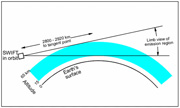|
|
| A SWIFT eye on winds in the upper atmosphere |
|
|
Winds high above the Earth's surface in the stratosphere have a major effect on climate and weather. In the coming years, a unique Canadian instrument will measure these winds.
SWIFT is the main instrument on the Canadian Space Agency's Chinook satellite scheduled for launch in late 2010. It will provide the first three-dimensional maps of winds around the globe, 20 to 55 kilometres above the surface in the stratosphere.
In particular, the Chinook mission will track how ozone is moved toward the North and South Poles. |

"SWIFT" stands for "stratospheric wind interferometer for transport" This is a concept drawing of the instrument. Click to enlarge
(Image: Ian McDade)
|
Canada's SWIFT team
| "There have been very few measurements of winds in the stratosphere, and that's where most of the ozone is," says SWIFT principal investigator Professor Ian McDade of York University.
"The movement of ozone from the tropics, where most of it is produced, towards the poles is fairly well understood. It is known as the Brewer-Dobson circulation.
"But we don't know how to predict how fast the ozone will move toward the poles, or how the movement will vary from year to year," says Dr. McDade. "This is important for making better forecasts of ozone change. We will better understand the difference between natural ozone cycle variations and ozone depletion caused by substances introduced by human activity." |

Scientists will use data from SWIFT to determine how stratospheric winds move ozone from the tropics to the poles, creating the ozone hole. Click to enlarge. (Image: NASA)
|
Capturing the ozone glow
| SWIFT works like a camera to capture light; it sees thermal infrared light. All matter, including ozone, emits light in the infrared part of the light spectrum. Researchers will use SWIFT's infrared light measurements of the moving ozone to determine the speed and direction of the winds in the stratosphere.
Dr. McDade and the SWIFT team are already preparing for the data processing and scientific analysis. "It isn't easy to extract the wind speed information from infrared photos," he says.
|

Side view of SWIFT viewing geometry. Click image
to enlarge.
(Image: Ian McDade)
|
Better forecasting
Today's weather forecasts are based on daily measurements of temperature, humidity, wind, and air pressure from weather balloons. Launched at specific times around the world, they track conditions to about 30 kilometres above the surface. SWIFT will provide continuous data from higher altitudes in the stratosphere.

SWIFT will also demonstrate the use of stratospheric wind measurements to improve
medium-range weather forecasts. (Source: NASA)
"New insights into stratospheric winds could be used to correct the wind component in atmospheric computer models. This would make them more reliable for predicting the weather three or four days ahead," says Dr. McDade. "If we show how information from SWIFT can improve weather forecasts, there will be a lot more commercial interest in the data."
| The models also make it possible to understand what state the ozone layer is in, and how it is evolving, so we can better understand the climate of the future. SWIFT and the Chinook mission will greatly advance computer models for both climate and weather forecasts. |

SWIFT is part of the Chinook satellite.
(Image: Ian McDade)
|
|
